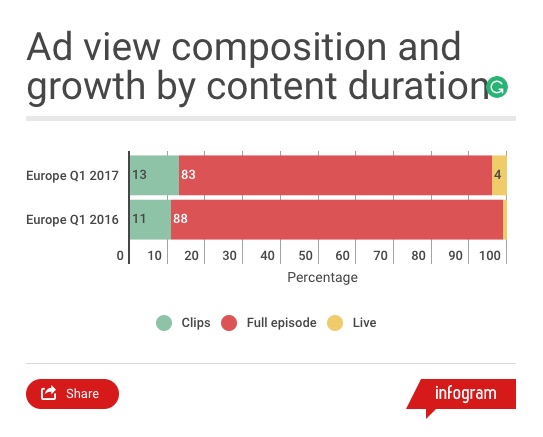Save 50% on a 3-month Digiday+ membership. Ends Dec 5.
The explosion of live video means anyone can become a broadcaster, which often results in varying degrees of quality. While still nascent, live-streaming video is becoming more cluttered as more platforms join the fold. Here’s a look at how live streaming is changing.
Facebook Live grabs headlines, but YouTube is still the front-runner
Facebook’s massive reach and financial incentives meant that a lot of brands and media companies charged headfirst into live streaming in 2016. But YouTube is still the No. 1 platform where people view live streams, according to the Media Futures report from research consultancy Magid, with 45 percent of respondents using YouTube to view live-stream video, compared to 24 percent on Facebook Live.

Facebook is responsible for much of the growth in the format, though. A UBS Evidence Lab report via eMarketer from January 2017 found that the amount of live-stream video viewed on Facebook increased from 14 percent to 17 percent over six months. Other platforms have experienced drop-offs; 21 percent of respondents watched live-stream video on YouTube, compared to 16 percent six months later. EMarketer senior analyst Paul Verna suggested this is because the market is still in its infancy, rather than due to poor platform performance.
Live news is more popular than long-form video on video platforms
The number of places where viewers can live stream is exploding. Reuters Digital News Report split the environments into feed-based social networks like Facebook and Twitter, search-based platforms like YouTube and news websites and apps. It also categorized content as short-form (less than five minutes), long-form (more than five minutes) and live.

Short-form video is the most popular format, according to the report. Live video is more popular than longer-form video on platforms like YouTube, where in a given week, 15 percent of respondents watch live news and 12 percent watch longer news video. On news websites and social media platforms, longer-form news video is more popular than live.
Ad position: web_incontent_pos1
Ads have arrived in live video in Europe
The number of ads within live video formats is growing, albeit from a low base. A FreeWheel report on Europe showed 4 percent of ad views occur in live-stream video content, up 11 percent year over year. The report defines video as clips, which are less than five minutes long, and full episodes, which are longer than five minutes.

This growth in Europe follows the trend in the U.S. and has been mostly driven by live sporting events, but live news video is growing as a content vertical, according to FreeWheel. In the U.S., 78 percent of live video covered live sporting events; 16 percent was news. In 2016, news made up just 9 percent of live video content.
Streaming services overload
Without a clear way to monetize live streaming through advertising on social networks, subscriptions and owned and operated platforms are the most viable monetization route. Here, younger people are likely to pay for one, possibly two, different streaming services, of which Netflix remains the dominant player, according to a recent poll on U.S. views from research company Morning Consult.

Ad position: web_incontent_pos2
According to the same report, 67 percent of 18- to 29-year-olds subscribe to Netflix, with 28 percent of young people paying for Amazon Prime. The Morning Consult poll found 42 percent of 18- to 29-year-olds believe they are paying too much for streaming services — 21 percent spend from $11 (£9) to $20 (£16) a month — while 57 percent of young people agree there are too many streaming services.
More in Future of TV

Future of TV Briefing: The streaming ad upfront trends, programmatic priorities revealed in Q3 2025 earnings reports
This week’s Future of TV Briefing looks at what TV and streaming companies’ latest quarterly earnings report indicate about the state of the streaming ad market.

Future of TV Briefing: The creator economy needs a new currency for brand deals
This week’s Future of TV Briefing looks at why paying creators based on reach misses the mark and what IAB is doing to clear up the creator-brand currency situation.

Future of TV Briefing: WTF is IAB Tech Lab’s device attestation tactic to combat CTV ad fraud?
This week’s Future of TV Briefing breaks down the CTV ad industry’s new tool for fighting device spoofing.
Ad position: web_bfu


